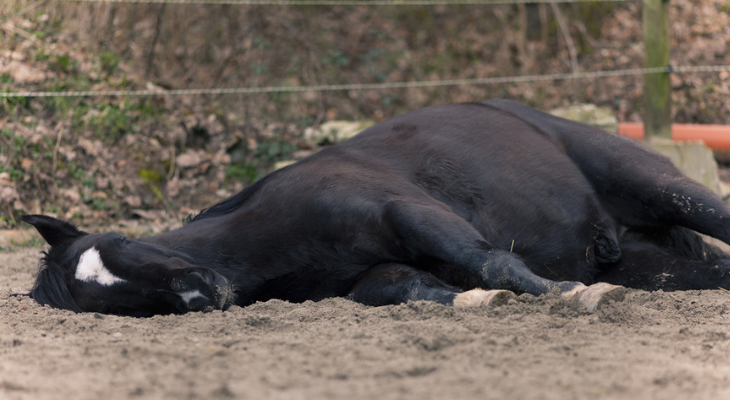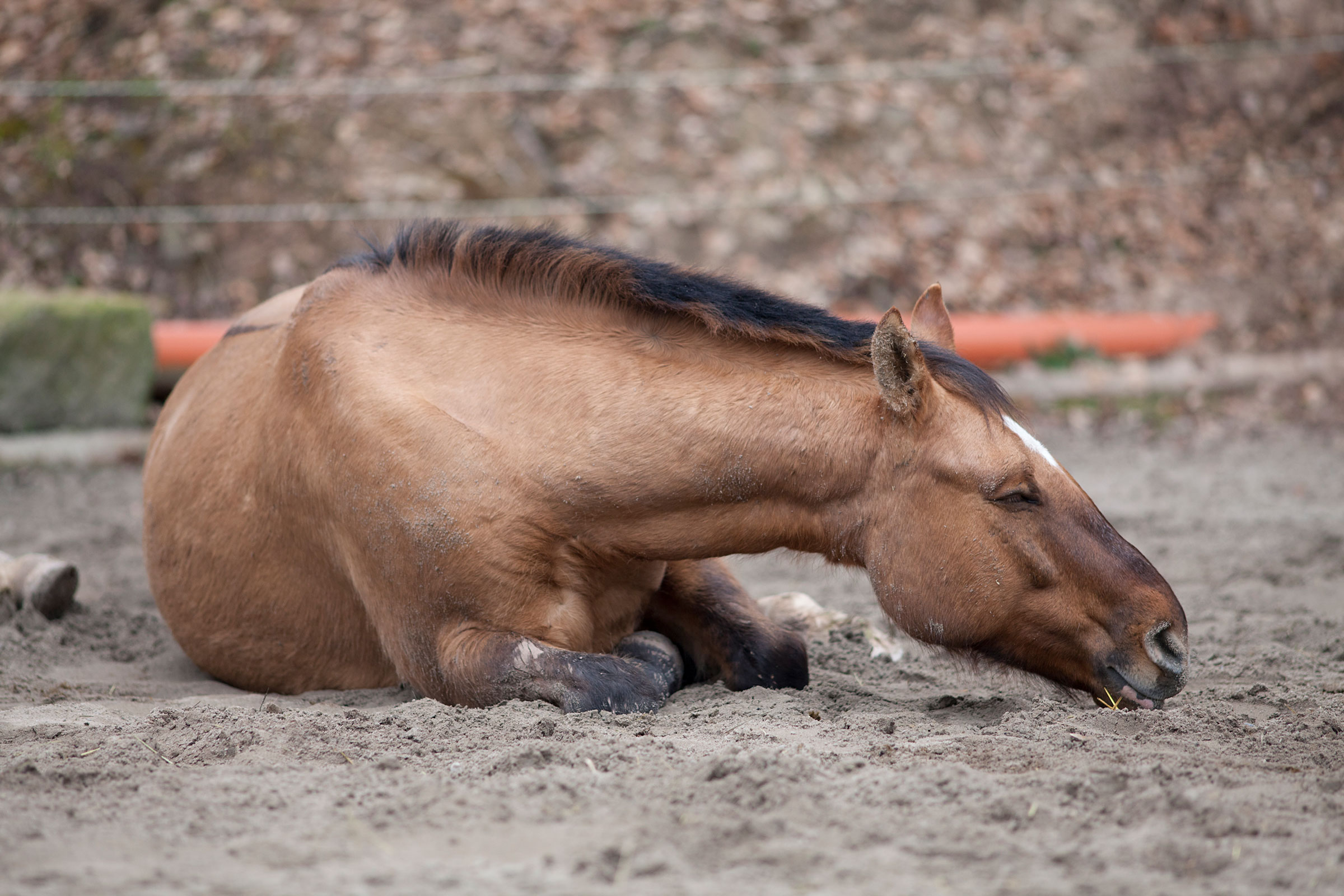Fever in Horses
A normal adult horse’s rectal temperature is 99–101 °F (37.2–38.3 °C). Fever is any reading above 101.5 °F (38.6 °C). Temperatures at or above 104.0 °F (40.0 °C) are an emergency, and any fever in a foal is urgent. Always confirm with a clean, lubricated digital rectal thermometer; keep a tail hold and wait for the full read.

In the first hour
Confirm the temperature with a digital rectal thermometer, then record full vitals—heart rate, respiratory rate, mucous membranes and capillary refill time, and hydration checks—and recheck temperature every 2–4 hours. Isolate the horse, use separate buckets and tools, avoid nose-to-nose contact, and handle this horse last. Keep the horse cool with shade and airflow, remove blankets, and offer fresh water; plain salt or a veterinarian-approved electrolyte may be appropriate if dehydration is a risk. Call your veterinarian promptly for 102.6–103.9 °F (39.3–39.9 °C), immediately at ≥104.0 °F (≥40.0 °C), or anytime there is depression, not drinking, cough or nasal discharge, diarrhea, colic pain, labored breathing, neurologic signs, or if the patient is a foal.
What counts as a fever
If your horse’s rectal temperature is above 101.5 °F (38.6 °C), act calmly and follow these safe, vet-aligned steps while you arrange advice. Any foal fever or ≥104.0 °F (≥40.0 °C) is an emergency.
Confirm an accurate rectal temperature
Use a clean, lubricated digital rectal thermometer; keep a tail hold and wait for the full read.
Record full vital signs
Log heart rate, respiratory rate, mucous membranes, capillary refill time, hydration checks, and the time taken.
Isolate and use biosecurity
Separate buckets and tools, avoid nose-to-nose contact, handle this horse last, and wash hands/boots.
Encourage drinking
Provide fresh water immediately; plain salt or a veterinarian-approved electrolyte is appropriate if dehydration risk.
Cooling if uncomfortable or hot
Offer shade and airflow; remove blankets. Tepid hosing with scraping is acceptable—avoid chilling or ice baths.
Call your veterinarian
Same day for 102.6–103.9 °F (39.3–39.9 °C); immediately at ≥104.0 °F (≥40.0 °C), or for any foal or red-flag signs.
First-hour plan: owner-safe steps
01
Confirm temperature
Use a clean, lubricated digital rectal thermometer; hold for the full read and keep a tail hold.
02
Record full vitals
Note heart rate, respiratory rate, mucous membranes, capillary refill time, hydration checks; log times.
03
Isolate with biosecurity
Separate buckets and tools, avoid nose-to-nose contact, handle this horse last, wash hands and boots.
04
Offer water
Provide fresh water immediately; plain salt or veterinarian-approved electrolytes if dehydration risk.
05
Cooling, if needed
Shade and airflow; remove blankets. Tepid hosing with scraping is acceptable—avoid chilling or ice baths.
06
Call your veterinarian
Same day for 102.6–103.9 °F (39.3–39.9 °C); immediately at ≥104.0 °F (≥40.0 °C) or if foal or other red flags.
Red Flags for Horse Fever: When to Call or Trailer Now
These signs mean you should speak to a veterinarian immediately. If trailering is advised, follow the vet’s instructions first—some cases are safest to keep isolated on site.

Temperature ≥104.0 °F (≥40.0 °C)
This level is an emergency due to risks of dehydration and complications. Begin safe cooling (shade, airflow, tepid hosing with scraping) while contacting your veterinarian.

Any fever in a foal or late-term broodmare
Foals (≤30 days) with ≥102.0 °F (≥38.9 °C) need immediate veterinary care. Fever in late-term mares also warrants urgent assessment.

Breathing problems with fever
Cough, thick nasal discharge, fast or labored breathing, noise (stridor), or flared nostrils suggest respiratory disease. Isolate and call your vet.

Diarrhea or rapid dehydration
Loose or foul-smelling manure, tacky gums, sunken eyes, or reduced urine can escalate quickly. Offer water and call your veterinarian at once.

Neurologic signs with fever
Stumbling, weakness, head tilt, abnormal mentation, or inability to stand require immediate veterinary guidance and strict handling precautions.

Recent travel, new arrivals, or known barn cases
Fever after shows/transport or where strangles/PHF is present increases outbreak risk. Isolate strictly and contact your veterinarian for testing and biosecurity advice.
Likely Causes of Horse Fever by Season & Context
These are common, owner-facing differentials to discuss with your veterinarian. Use them to guide isolation and biosecurity while you seek medical advice—only a vet can diagnose.

Viral respiratory infection
Frequent in barns with recent travel or new arrivals; fever may precede cough and nasal discharge. More activity in cool seasons and crowded stabling.

Strangles (Streptococcus equi)
Highly contagious. Fever often comes before swollen lymph nodes and thick nasal discharge. Strict isolation and separate water sources are essential.

Potomac Horse Fever (PHF)
Seasonal risk near rivers, canals, or irrigated pastures—typically late spring through fall. Fever may be followed by decreased appetite and diarrhea.

Anaplasmosis (tick-borne)
Seen in some regions in fall and winter. Fever with lethargy; tick exposure or wooded turnout increases likelihood.

Pneumonia / pleuropneumonia
Fever with cough, fast or painful breathing, or nasal discharge; risk increases after long transport or a recent viral illness.

Colitis / enteritis
Fever with diarrhea and dehydration; may follow sudden diet change or certain illnesses. Rapid fluid loss makes this urgent.
What to Tell Your Veterinarian
Share clear, time-stamped facts. These details help your vet judge urgency, triage infectious risks, and decide testing or treatment. Avoid medications unless your vet directs you.
Report exact rectal temperatures with times. Adult fever is >101.5 °F (38.6 °C); ≥104.0 °F (≥40.0 °C) is an emergency. Note if it’s rapidly rising.
Heart rate, respiratory rate, mucous membranes and capillary refill time, hydration checks. Include behaviour (depressed, not eating) and any cough or nasal discharge.
How much the horse drank, ate, and the timing/appearance of urine and manure. Mention diarrhea or reduced output.
Recent shows/transport, new horses on property, or known cases in the barn (e.g., strangles or PHF). Note shared water sources.
List any NSAIDs, antibiotics, supplements, vaccines, dewormers, or sudden feed/pasture changes with dates and doses if known.
Age, sex, use (performance/retired), pregnancy or foal age. Add video/photos if breathing effort, nasal discharge, or manure appearance is abnormal.
Horse Fever FAQ: Fast Answers for Owners
What temperature is a fever in an adult horse?
Above 101.5 °F (38.6 °C). Normal adult range is 99–101 °F (37.2–38.3 °C). Recheck to confirm an accurate reading.
How do I take an accurate rectal temperature?
Use a clean, lubricated digital rectal thermometer. Stand safely to the side, keep a tail hold, insert gently just past the bulb, and wait for the full read. Clean and disinfect after.
When is a fever an emergency?
At ≥104.0 °F (≥40.0 °C), or any fever in a foal. It’s also urgent if there is depression, not drinking, diarrhea, cough or nasal discharge, labored breathing, colic pain, or neurologic signs.
Should I give medication before the vet arrives?
No. Do not give any medication unless your veterinarian directs you. Some drugs mask important clues and certain combinations are unsafe.
How often should I recheck the temperature and other vitals?
Every 2–4 hours while signs persist, or as your veterinarian advises. Log the time, temperature, heart rate, respiratory rate, mucous membranes, and hydration checks.
Can heat or exercise cause a temporary temperature rise?
Yes—work and hot weather can raise body temperature briefly. Let the horse rest in shade with airflow, then recheck after 20–30 minutes. Persistent readings >101.5 °F (38.6 °C) are considered fever.
Useful links
Quick, owner-safe references to check vitals, review likely infectious causes, and support hydration while you contact your veterinarian.
